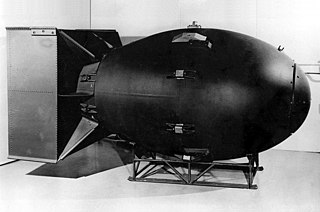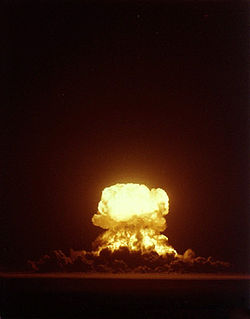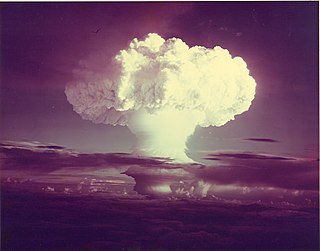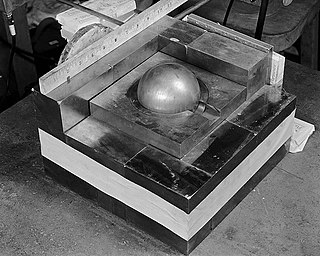
Nuclear weapon designs are physical, chemical, and engineering arrangements that cause the physics package of a nuclear weapon to detonate. There are three existing basic design types:

Yellow Sun was the first British operational high-yield strategic nuclear weapon. The name actually refers only to the outer casing; the warhead was known as "Green Grass" and "Red Snow". The ENI or electronic neutron initiator (generator) was Blue Stone.
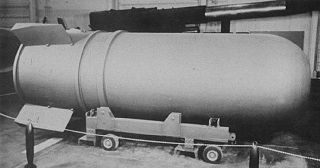
The B-41 was a thermonuclear weapon deployed by the United States Strategic Air Command in the early 1960s. It was the most powerful nuclear bomb ever developed by the United States, with a maximum yield of 25 megatons. The B-41 was the only three-stage thermonuclear weapon fielded by the U.S.

The W85 was a thermonuclear warhead developed by the United States of America to arm the Pershing II missile. It had a variable yield and was often referred to as "dial-a-yield" which could be set between 5 and 80 kilotons.

Mark 7 "Thor" was the first tactical fission bomb adopted by US armed forces. It was also the first weapon to be delivered using the toss method with the help of the low-altitude bombing system (LABS). The weapon was tested in Operation Buster-Jangle. To facilitate external carry by fighter-bomber aircraft, Mark 7 was fitted with retractable stabilizer fins. The Mark 7 warhead (W7) also formed the basis of the 30.5 inches (775 mm) BOAR rocket, the Mark 90 Betty nuclear depth charge, MGR-1 Honest John rocket, and MGM-5 Corporal ballistic missile. It was also supplied for delivery by Royal Air Force Canberra aircraft assigned to NATO in Germany under the command of SACEUR. This was done under the auspices of Project E, an agreement between the United States and the UK on the RAF carriage of US nuclear weapons. In UK use it was designated 1,650 lb. H.E. M.C. The Mark 7 was in service from 1952 to 1967(8) with 1700–1800 having been built.

Gun-type fission weapons are fission-based nuclear weapons whose design assembles their fissile material into a supercritical mass by the use of the "gun" method: shooting one piece of sub-critical material into another. Although this is sometimes pictured as two sub-critical hemispheres driven together to make a supercritical sphere, typically a hollow projectile is shot onto a spike which fills the hole in its center. Its name is a reference to the fact that it is shooting the material through an artillery barrel as if it were a projectile. Other potential arrangements may include firing two pieces into each other simultaneously, though whether this approach has been used in actual weapons designs is unknown.

The W84 is an American thermonuclear warhead designed for use on the BGM-109G Gryphon Ground Launched Cruise Missile (GLCM). It is a derivative of the B61 nuclear bomb design and a close relative of the W80 warhead used on the AGM-86 ALCM, AGM-129 ACM, and BGM-109 Tomahawk SLCM cruise missiles.

The W9 was an American nuclear artillery shell fired from a special 11 inch howitzer. It was produced starting in 1952 and all were retired by 1957.
The B46 nuclear bomb was an American high-yield thermonuclear bomb which was designed and tested in the late 1950s. It was never deployed. Though originally intended to be a production design, the B46 ended up being only an intermediate prototype which was test fired several times. These prototypes were known as TX-46 units (Test/Experimental).
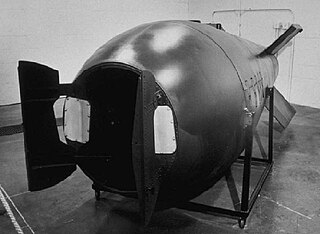
The Mark 5 nuclear bomb and W5 nuclear warhead were a common core nuclear weapon design, designed in the early 1950s and which saw service from 1952 to 1963.

The Mark 8 nuclear bomb was a nuclear bomb, designed in the late 1940s and early 1950s, which was in service from 1952 to 1957.
The W30 was an American nuclear warhead used on the RIM-8 Talos surface-to-air missile and the Tactical Atomic Demolition Munition (TADM).

The Mark 15 nuclear bomb, or Mk-15, was a 1950s American thermonuclear bomb, the first relatively lightweight thermonuclear bomb created by the United States.

Upshot–Knothole Grable was a nuclear weapons test conducted by the United States as part of Operation Upshot–Knothole. Detonation of the associated nuclear weapon occurred 19 seconds after its deployment at 8:30am PDT on May 25, 1953, in Area 5 of the Nevada Test Site. The codename Grable was chosen because the letter Grable is phonetic for G, as in "gun", since the warhead was a gun-type fission weapon. As a shell, or artillery-fired atomic projectile (AFAP), the device was the first of its kind. The test remains the only nuclear artillery shell ever actually fired in the U.S. nuclear weapons test program.
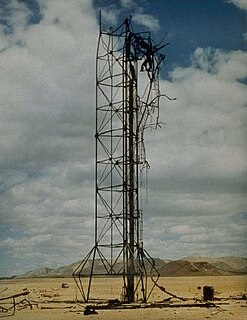
The uranium hydride bomb was a variant design of the atomic bomb first suggested by Robert Oppenheimer in 1939 and advocated and tested by Edward Teller. It used deuterium, an isotope of hydrogen, as a neutron moderator in a uranium-deuterium ceramic compact. Unlike all other fission-based weapon types, the concept relies on a chain reaction of slow nuclear fission. Bomb efficiency was adversely affected by the cooling of neutrons since the latter delays the reaction, as delineated by Rob Serber in his 1992 extension of the original Los Alamos Primer.
Swan was a United States test nuclear explosive, which was developed into the XW-45 warhead.


